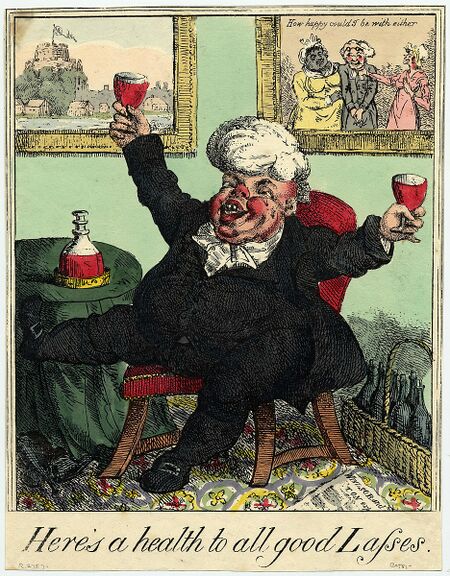Annotation:Here's a health to all good lasses: Difference between revisions
No edit summary |
No edit summary |
||
| (3 intermediate revisions by the same user not shown) | |||
| Line 2: | Line 2: | ||
{{TuneAnnotation | {{TuneAnnotation | ||
|f_tune_annotation_title= https://tunearch.org/wiki/Annotation:Here's_a_health_to_all_good_lasses > | |f_tune_annotation_title= https://tunearch.org/wiki/Annotation:Here's_a_health_to_all_good_lasses > | ||
|f_annotation=[[File:Lasseshealth.jpg|right|450px|thumb|George Cruikshank (?), 1818.]]'''HERE'S A HEALTH TO ALL GOOD LASSES.''' English, Air (2/4 time). D Major. Standard tuning (fiddle). One part. A much-anthologized song [Roud 1235], printed in Edward Jones's '''Musical Bouquet, or popular songs and ballads''' (London, 1799, p. 34), '''London Minstrel''' (1820), '''Universal Songster and Museum of Mirth''' (1825) and similar songsters and chapbooks from the end of the 18th century through the 19th. | |f_annotation=[[File:Lasseshealth.jpg|right|450px|thumb|George Cruikshank (?), 1818.]]'''HERE'S A HEALTH TO ALL GOOD LASSES.''' English, Air (2/4 time). D Major. Standard tuning (fiddle). One part. A much-anthologized song [Roud 1235], printed in Edward Jones's '''Musical Bouquet, or popular songs and ballads''' (London, 1799, p. 34), '''London Minstrel''' (1820), '''Universal Songster and Museum of Mirth''' (1825) and similar songsters and chapbooks from the end of the 18th century through the 19th. It was derived from a part-song by Pietro Guglielmi (1728–1804), and often set as a glee (a song in parts for men). "Here's a health to all good lasses" was a favorite of London “Song & Supper” clubs, and found its way into rural tradition in Cumberland, Oxfordshire, Dorset, the Isle of Mann and numerous other places. | ||
<br> | |||
These words are from a chapbook dated 1800: | |||
<blockquote> | |||
''Here’s a health to all good lasses;''<br> | |||
''Here’s a health to all good lasses;''<br> | |||
''Here’s a health to all good lasses;''<br> | |||
''Pledge it merrily, fill your glasses:''<br> | |||
''Let a bumper toast go round.''<br> | |||
''Here’s a health, &c.''<br> | |||
<br> | |||
''All good lasses like a trumper;''<br> | |||
''Fill your glasses, here’s a bumper:''<br> | |||
''Blithe and merry may they be.''<br> | |||
''Here’s a health &c.''<br> | |||
<br> | |||
''May they live a life of pleasure,''<br> | |||
''Without mixture, without measure,''<br> | |||
''For with them true joys are found.''<br> | |||
''Here’s a health, &c.''<br> | |||
</blockquote> | |||
The melody, sometimes set in parts for singing, can be found in several English musicians' manuscript collections, including William Killey (mid-19th cent., Jurby, Isle of Man), Joshua Gibbons (1823, Tealby, Linclonshire), Rev. R. Harrisn (Cumberland, c. 1815), and William Irwin (c. 1850). Another Isle of Man version can be found in the ms. of John Moore (1804), similar only through the first eight bars, before it deviates significantly. | |||
|f_source_for_notated_version= | |f_source_for_notated_version= | ||
|f_printed_sources=Edward Riley ('''Riley’s Flute Melodies vol. 1'''), New York, 1814; No. 200, p. 52. | |f_printed_sources=Edward Riley ('''Riley’s Flute Melodies vol. 1'''), New York, 1814; No. 200, p. 52. | ||
Latest revision as of 23:21, 29 April 2024
X:1 T:Here’s a health to all good lasses M:2/4 L:1/8 B:Edward Riley – “Riley’s Flute Melodies vol. 1” (New York, 1814, No. 200, p. 52) B: https://archive.org/details/flutemelodies0000rile/page/n55/mode/2up Z:AK/Fiddler’s Companion K:D d>e|gdgf|ed f>g|afba|gfaa|aaba|aggg|ggag |gf a>a| bbac|d2 a>a|bbac|d2 de|fdec|ddde|fdec|d2 b>b| afge |d2 ab|ge A/B/c/A/|dd ab|ge A/B/c/A/|dd aa| aaba|aggg|ggag|gf a>a|bbac|d2 a>a|bbac|d2||

These words are from a chapbook dated 1800:
Here’s a health to all good lasses;
Here’s a health to all good lasses;
Here’s a health to all good lasses;
Pledge it merrily, fill your glasses:
Let a bumper toast go round.
Here’s a health, &c.
All good lasses like a trumper;
Fill your glasses, here’s a bumper:
Blithe and merry may they be.
Here’s a health &c.
May they live a life of pleasure,
Without mixture, without measure,
For with them true joys are found.
Here’s a health, &c.
The melody, sometimes set in parts for singing, can be found in several English musicians' manuscript collections, including William Killey (mid-19th cent., Jurby, Isle of Man), Joshua Gibbons (1823, Tealby, Linclonshire), Rev. R. Harrisn (Cumberland, c. 1815), and William Irwin (c. 1850). Another Isle of Man version can be found in the ms. of John Moore (1804), similar only through the first eight bars, before it deviates significantly.

